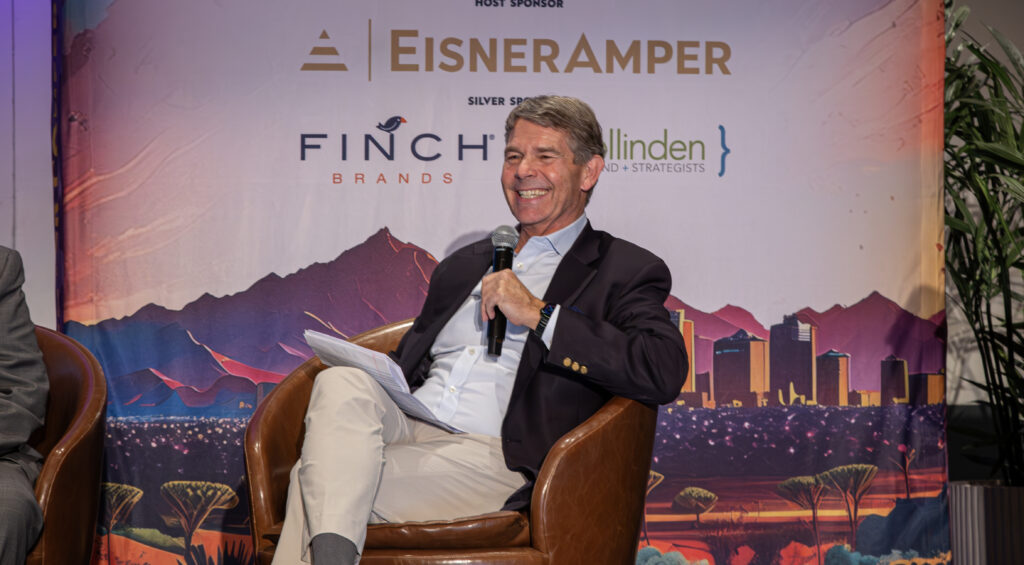
The first General Session at AM&AA Winter Conference 2025
The AM&AA Winter Conference featured a number of the industry’s top speakers, sharing their perspectives on the future of mergers and acquisitions as we begin a new year.
By Eric C. Peck
From January 21-22, the AM&AA Winter Conference was held in Scottsdale, Arizona, featuring educational content and networking opportunities, providing sponsors, attendees, and speakers valuable face-to-face time to discuss the industry’s hottest topics.
With the top minds in the mergers and acquisitions space under one roof, the event featured a number of educational sessions presented by some of the top minds in the industry sharing their insight and expertise with those in attendance.
The first General Session of the event focused on the future of the M&A space. Presented by EisnerAmper, the “Market Update: New Year, Brighter Future for M&A” session featured industry experts in the middle market M&A and private equity space sharing current market characteristics, including data on completed transactions. The discussion included a current market assessment on valuation, deal structuring, and leverage.
A panel of experts, including Graeme Frazier, President of Private Capital Research LLC; Allan Siposs, Managing Director of Keystone Capital Markets; Andrew Tomat, Managing Director of Four Pillars Inc.; and Sharon Heaton, CEO of sbLiftOff, kicked off the discussion by recapping the past few years in the M&A space, and how the market has recovered in the post-pandemic era.
Frazier set the tone by outlining the state of the M&A market over the past few years, noting that 2021 marked a peak in M&A activity, and 2023 seeing significant declines due to high inflation, increased interest rates, and global uncertainty, followed by 2024 showing early signs of recovery.

Graeme Frazier
“Rates came down off their peak … and lenders started to go a little more risk-on, so the spreads on rates have also come back,” said Frazier.
Looking into 2025 and beyond, Tomat noted factors that will shape the M&A market moving forward.
“One of the headlines you’re going to see in the year ahead is the strength and the activity from foreign buyers. Many of my clients are in industrial companies, privately owned in the European area, and for the last 20 years, they have spent all of their energies on building a world-class supply chain, primarily out of China,” noted Tomat. “Those markets are extremely flexible, agile, and they are able to respond to demand at a great late speed. Over the past 10 years they have diversified that a little bit by expanding into what we would call a ‘China Plus One’ strategy … setting up another factory in, say, Vietnam or Mexico. What the mandates are coming now down that we’re just starting to work on from our clients is I need to set up manufacturing in the U.S. We’ve been talking about this for a long time. The threat of tariffs has really pushed them over the line to want to establish a base here.”
Heaton continued the discussion and explained the importance of supply chain issues moving forward.
“Supply chain, at least in the federal government area, is becoming a critical issue,” said Heaton. “So much of supply chain has some level of technology built into it. The question becomes … can you trust whatever that technology is or are things being embedded in there that can cause national security concerns? One of the reasons why there was inflation, clearly the government spent a huge amount of money, but there was also a supply chain problem. We were not able to get goods and equipment into the United States that people wanted, so the prices were bid up. Supply chain I think is going to be extremely important as we move deeper into 2025.”
When asked about the factors that are going to cause a business owner to decide to sell in the first half of 2025, the panelists shared their varying opinions.
Heaton explained, “To the extent that a company cannot decide if they want to sell or not, there’s a middle ground. If you sell part of it, you can bring capital into the company, get some new energy, and bring it to that next level. So, there is something that is an intermediary between those levels, and I think that we might be seeing more of these types of situations.”
Tomat noted a generational shift in perspective in the market, explaining that, “There are always generational aspects. We look at a company and the first thing I look at is to check on LinkedIn and get an idea of maybe how old they are. Are they in their 40s, 50s, 60s? That will give you an idea of what might motivate them. The other thing is a lot of people do not have experience with European buyers, but they are buying whole forever. They tend to take a long time to make a decision, but then they are also willing to work. They want majority control, but they encourage the owner to stay on.”
Siposs continued, “Certainly the preponderance now of independent sponsors in the marketplace seems to be driving an appetite for smaller deals, harder for a more traditional fund to get done, and they have both private and institutional credit that they have tapped into as you know. So that is what we are seeing in addition.”
In wrapping the panel discussion, the panel was asked to weigh in on the next six months as the M&A market begins to take shape in 2025. Overall, the panel shared general optimism for 2025, particularly in the second half, as uncertainty diminishes, and market fundamentals stabilize.
Tomat explained, “It depends on the sector. We are dabbling in stuff that is on the AI hardware side including data centers. Even in some legacy areas like with the renewal fracking, there is going to be a lot of oil services business, underground construction. So, some legacy markets that you thought were long gone, I think you are going to see a surge in the year ahead.”
Added Siposs, “Marginally up and to the right is my prediction for the year. I think all else being equal, it’s going to be a receptive environment for business owners. I do think that buyers are hungry. There is a lot of capital on the sidelines, but they are looking for good deals.”
Heaton commented, “I think that the M&A transactions you will see in the Wall Street Journal will increase. I mean, if you wanted to do a deal in 2023 or 2024 and it was a Google buying whatever, you knew there was going to be an issue. Now I think that those deals are more likely to go flying through. If you are just looking at the newspapers, we are going to see a lot about deals. I am not sure it is going to have a significant impact on the deals that are $50 million and below. I think that is going to continue to be slow and steady without the suppression factor being, getting the leverage to close those transactions.”
Finally, Frazier closed the session with his prognosis of the M&A market for the remainder of 2025 moving forward.
“I see us getting into a better year than 2024,” noted Frazier. “I don’t think it’s going to be total blue sky, but there’s a lot of reasons why the market is fundamentally improving.”
AM&AA will be bringing full coverage of its 2025 Winter Conference and its panel discussions in the coming weeks. In addition to the “Market Update: New Year, Brighter Future for M&A” session, the lineup of Winter Conference speakers included executives from top investment banks and intermediaries, private equity investors, senior and mezzanine lenders, CPAs, attorneys, business valuators, consultants, and other M&A advisors, representing countries from all over the world.
The AM&AA Summer Conference has just been announced! To learn more about the conference and save on registration with Early Bird Pricing, use the link below.





